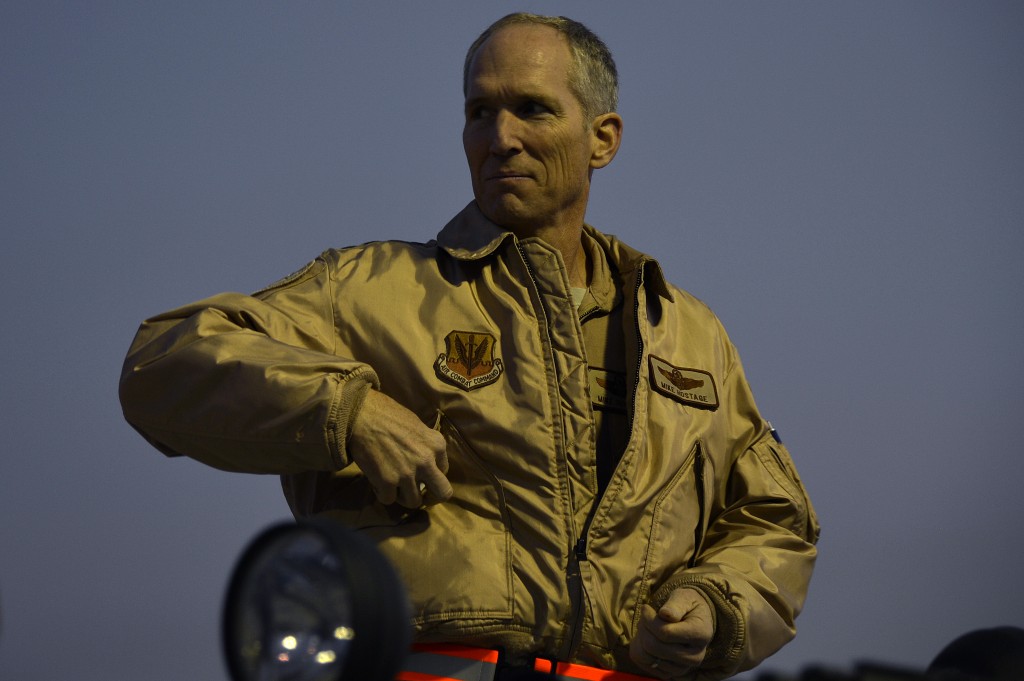
Gen. Mike Hostage at Bagram Airfield, Afghanistan in 2013.
“Our industrial base has eroded and we’re reducing our military down to a skeletal size at a time when the world is looking crazier by the day,” Gen. Mike Hostage told reporters Tuesday at the Air Force Association’s annual conference.
“[But] there is nothing happening right now that is going to make sequestration go away, so we’re going to live with the sequestered federal budget.” With his retirement just seven weeks away, the Air Combat Command chief admitted that he’s finding it easier to speak his mind about what budget politics is doing to the future of Air Force he’s served for 37 years. He’s not happy about it. “I believe in civilian leadership of the military,” he said.
“My job is to provide the best military advice. If somebody doesn’t want to take it, wants to make a less than perfect military decision, I accept that. That is our system. I’m okay with that. But what I can’t abide by is being told, ‘No, don’t say that, you can’t say that.’” One decision Hostage particularly lamented was the move to retire the venerable, high-flying U-2 spyplane and replace it with RQ-4 Global Hawk drones – even though there aren’t enough Global Hawks yet to provide the same coverage. Keeping the U-2s actually was the Air Force plan until last March, when Secretary Deborah Lee James said that a drop in Global Hawk Block 30 sustainment costs justified the change in plan. It also happens that the Northrop-built Global Hawk has some passionate supporters in Congress, while the last new U-2 was built in 1989.
“The politics of it say, ‘Nope, you’re going to buy the Global Hawk and we’re not going to give you any more money to do ISR,” said Hostage. “That leaves me with ‘how do I pay for the remainder of Global Hawk?’” The answer: retire the U-2 — even though it will take eight years for the Global Hawk fleet to provide 90 percent of the capability of manned aircraft, Hostage said. “The combatant commanders are going to suffer for eight years and the best they’re going to get is 90 percent.“ Hostage was far more sanguine about the comparable decision to cancel the equally venerable A-10 Warthog ground attack aircraft.
In Afghanistan, he said, 70 percent of close air support was provided by other aircraft. The loss of the U-2, though, bothers him deeply. “You give the best military advice, then all the realities of politics and economics and all the other constraints” impose a different path, which the military then has to make work. “I’ll go to my grave making that happen,” Hostage said. “But don’t ask me to tell…everybody that that’s the best decision made.“
Among “other constraints” leaving Hostage frustrated as he ends his Air Force career is the fact that the service’s 4th and 5th generation fighter planes use different data links and thus “don’t talk to each other” – a particular problem when tight budgets will require flying those 4th generation fighters decades longer. He’s also “appalled” that the 5th generation F-35 and F-22 can’t communicate with each other via data link, either. Solving that problem is a top ACC priority, he said. The strategic shift toward Asia and the Pacific declared by President Obama adds other constraints.
The Air Force needs a new Combat Rescue Helicopter (CRH) to retrieve downed aircrew, Hostage said, but in a conflict with a peer competitor in Asia (code for “China”), vast distances and sophisticated air defenses might require the speed and countermeasures of Air Force Special Operations Command CV-22 Osprey tiltrotors. “Neither the A-10 nor the rescue helicopter are going to survive in a close-in IADS [Integrated Air Defense System] fight,” he said. In the near term, though, the danger to all these aircraft is the budget wars.
Sullivan: Defense industry ‘still underestimating’ global need for munitions
National Security Advisor Jake Sullivan said that there are “no plans” for another Ukraine supplemental at this point.


























